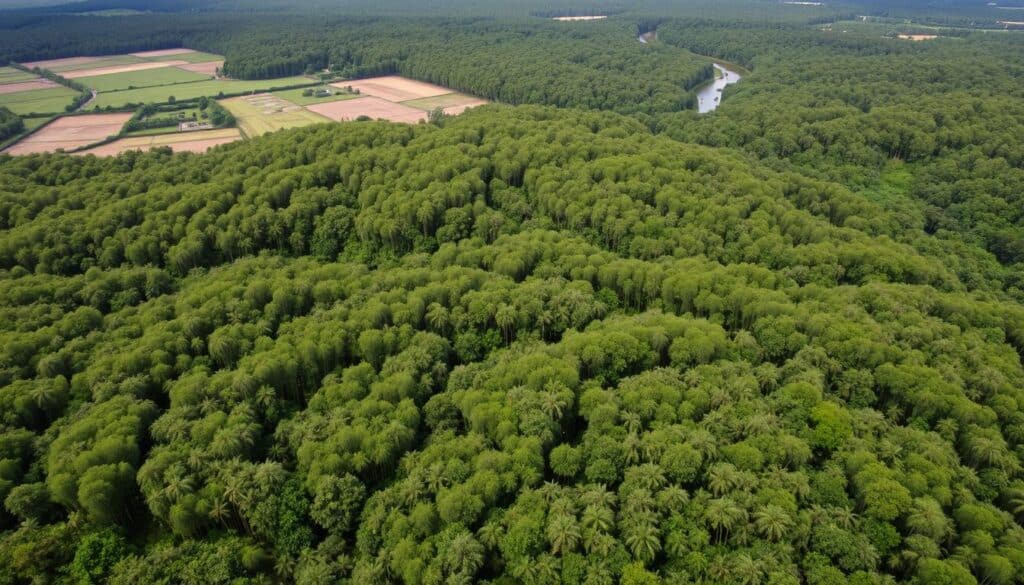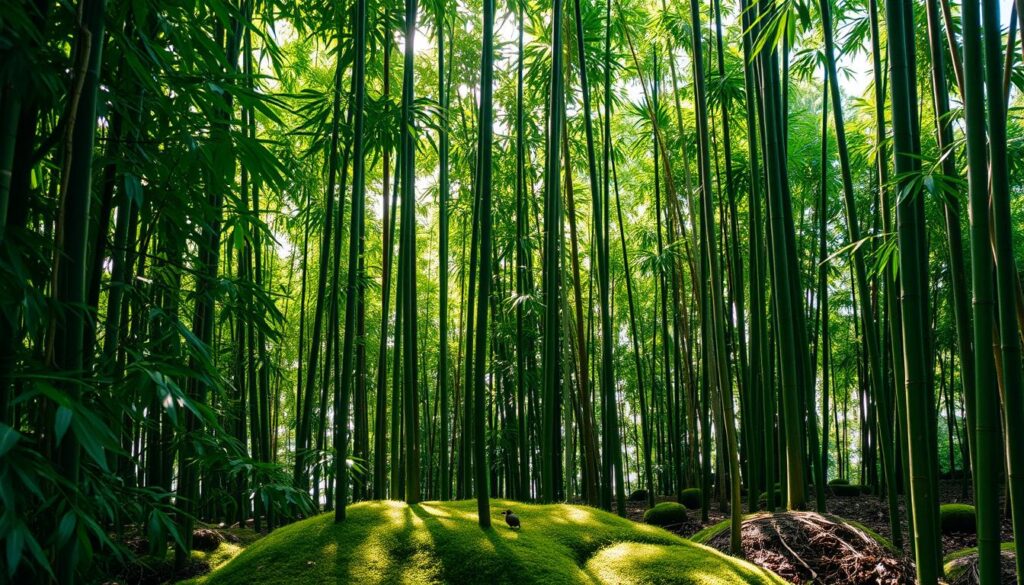Bamboo is key to the ecosystem that supports the Bamboo Ecosystem endangered giant panda. These iconic bears mainly eat bamboo. They live in bamboo forests in western China, helping to keep their habitat diverse.
As pandas roam through bamboo groves, they spread seeds and plant material. This helps the ecosystem stay healthy and grow. But, their home is shrinking due to human activities.
Now, pandas are found in only about 20 isolated bamboo forest patches in China. To save them, we need to create more nature reserves. This is vital for the giant panda’s survival.
This species has captured the world’s heart. It stands as a symbol of our efforts to protect nature.
Key Takeaways
- Bamboo is the primary food source and habitat for the endangered giant panda.
- Pandas play a vital role in the bamboo forest ecosystem by dispersing seeds and nutrients.
- Habitat loss due to human development has restricted pandas to 20 isolated bamboo forest patches.
- Expanding and creating new nature reserves is essential for the conservation of the giant panda.
- The bamboo ecosystem is a crucial component of the panda’s survival and the overall biodiversity of the region.
Giant Pandas and the Bamboo Forest
The giant panda is a symbol of conservation efforts. Its survival depends on bamboo forests. These animals eat a lot of bamboo, up to dozens of pounds a day.
They have special thumbs to grip bamboo. This helps them eat and move through their habitat.
Panda’s Reliance on Bamboo
Only about 1,864 giant pandas live in the wild. Another 600 live in zoos and breeding centers. They mostly eat bamboo, showing their unique evolution.
In the wild, they spend up to 16 hours eating bamboo. They also go to the bathroom a lot, up to 50 times a day.
Role of Pandas in Forest Ecosystem
Giant pandas are important in their forest home. They help spread bamboo seeds on their fur. This helps the forest stay healthy.
They also help by climbing and swimming. This spreads bamboo seeds further. It keeps the forest balanced.
| Statistic | Value |
|---|---|
| Giant pandas in the wild | 1,864 |
| Giant pandas in captivity | 600 |
| Giant panda breeding season duration | 24-72 hours |
| Successful births from artificial insemination at the Zoo | 4 |
| Estimated total giant panda population | Fewer than 1,900 |
“Giant pandas have a solitary nature with each individual confining its activities to a range of about 4 to 6 square km (1.5 to 2.3 square miles), although these home ranges often overlap significantly.”
Conservation Efforts for Bamboo Ecosystems

Bamboo ecosystems are vital for the giant panda and many other species. The Chinese government has set up over 2,500 nature reserves to protect these habitats. The Nature Conservancy and local partners are also working to manage China’s lands and waters sustainably.
Local communities, NGOs, and international groups like INBAR are key to conservation. They work on policies, sustainable harvesting, and restoring lands with native bamboo. This helps balance economic growth with protecting the environment.
The bamboo industry is worth $60 billion annually, showing its economic importance. Yet, over 400 bamboo species in Asia are endangered. Efforts aim to protect these species while supporting local economies.
Bamboo forests are home to endangered animals like the giant panda. They also support many other creatures, from insects to small mammals. These forests help keep ecosystems healthy by preventing soil erosion and stabilizing slopes.
Research on bamboo ecology and wildlife interactions is vital. It helps make conservation decisions and ensures these ecosystems last long.
Bamboo Ecosystem Under Threat

The bamboo ecosystem that supports the giant panda is facing serious challenges. Climate change is a major threat. Studies show that even with the best climate change scenarios, bamboo in the Qinling Mountains will die off. This will make the panda’s home uninhabitable by the end of the 21st century.
Climate change is not the only danger to bamboo. Unsustainable harvesting and agricultural expansion also harm bamboo forests. These threats put bamboo-dependent species like the Giant Panda at risk. Many bamboo species are already endangered, threatening global biodiversity and ecosystem services.
Impact of Climate Change
Understanding climate change’s impact on bamboo and wildlife habitats is key. Losing these ecosystems could harm forest environments and the species that depend on them. This includes the iconic Giant Panda.
| Bamboo Ecosystem Threats | Impact on Biodiversity |
|---|---|
| Climate change | Potential die-off of bamboo species in key panda habitats |
| Unsustainable harvesting | Endangerment of numerous bamboo-dependent species |
| Agricultural expansion | Deforestation and habitat loss for bamboo-reliant wildlife |
It’s vital to protect the bamboo ecosystem for the Giant Panda’s survival. It also helps keep forest ecosystems healthy worldwide. We need teamwork from conservation groups, research, and policymakers to tackle these threats. This will help save these vital natural resources for the future.
“Bamboo plays a crucial role in global ecosystems, providing habitat for numerous animal species. Preserving these fragile bamboo environments is essential for maintaining biodiversity and ecosystem services.”
The Bamboo Ecosystem: A Vital Network

The bamboo ecosystem is a complex network that supports many wildlife species. It plays a key role in the forest ecosystem. Bamboo’s fast growth and versatility offer food and shelter to many animals, including endangered ones.
This ecosystem’s connection to the forest ecosystem shows the need for a comprehensive conservation approach. Changes in one area can affect the whole ecosystem. This highlights the importance of maintaining the balance in these habitats.
There are over 1,600 bamboo species worldwide, found on every continent except Europe and Antarctica. Bamboo forests span 35-50 million hectares, home to millions of species. Some bamboo grows up to 36 inches in just 24 hours, showing its vital role.
| Bamboo Ecosystem Facts | Value |
|---|---|
| Bamboo species globally | Over 1,600 |
| Bamboo forest coverage | 35-50 million hectares |
| Fastest growth rate | 910 mm (36 in) in 24 hours |
| Bamboo’s annual global contribution | Over $60 billion |
The bamboo ecosystem is crucial for biodiversity and ecosystem services. It’s essential for the forest’s health. Protecting these habitats means understanding their complex connections.
“Bamboo forests, both natural and planted, cover 31.5 million hectares globally, and the global bamboo industries contribute more than USD 60 billion annually.”
Also Read : What Pandas Eat: 5 Fascinating Facts About the Panda Diet
Conclusion
The bamboo ecosystem is key for the giant panda, offering its main food and supporting the forest. Despite efforts, climate change threatens this ecosystem. We need a full plan to protect it, linking bamboo to the forest’s health.
Research, conservation, and green practices are vital for the bamboo and its many species. This ecosystem is rich in biodiversity and helps fight climate change. It also boosts local economies, showing its importance.
Protecting bamboo helps the giant panda and supports sustainable living. Working together, we can keep this special place alive. It will be a home for pandas and a step towards a greener future madagascar singh mountain gorillas cultivate textile biomass plant bamboo.
FAQs
Q: Why is bamboo crucial for the habitat of pandas?
A: Bamboo is a primary food source for giant pandas, making it essential for their survival. The bamboo plants provide both nourishment and shelter, creating a crucial ecosystem for these animals.
Q: How do red pandas depend on bamboo?
A: Red pandas primarily feed on bamboo shoots, which are rich in nutrients. Their reliance on bamboo makes the conservation of bamboo forests critical for their population stability.
Q: What are the benefits of using bamboo in forestry?
A: The use of bamboo in forestry contributes to biodiversity, as it supports various wildlife species. Bamboo is also a renewable resource that can be harvested sustainably, minimizing environmental impact.
Q: Can bamboo be considered an edible plant?
A: Yes, bamboo shoots are indeed edible and are used in various cuisines around the world. They are a healthy food option, rich in nutrients and low in calories.
Q: What role does bamboo play in carbon sequestration?
A: Bamboo plays an important role in carbon sequestration by absorbing carbon dioxide from the atmosphere, thus helping to reduce greenhouse gas emissions and combat climate change.
Q: How can bamboo be utilized in construction?
A: Bamboo is versatile and can be used as timber for construction. Its mechanical properties make it a strong and flexible material, suitable for building structures, flooring, and furniture.
Q: Is bamboo a renewable resource?
A: Yes, bamboo is renewable. It grows quickly and can be harvested every few years without damaging the plant, making it an environmentally friendly alternative to traditional timber.
Q: What is the significance of bamboo plantations in conservation efforts?
A: Bamboo plantations help restore degraded land and enhance biodiversity. They provide habitat for various species, including the endangered red panda and other wildlife, supporting ecological balance.
Q: How does bamboo contribute to the economy?
A: The international bamboo and rattan organisation promotes the economic potential of bamboo products, which can be made from bamboo fibers, bamboo charcoal, and other materials, creating job opportunities and supporting local communities.
Q: What are the characteristics of bamboo that make it unique?
A: Bamboo is known for its rapid growth, strong and lightweight structure, and adaptability to various environments. Its rhizome system allows for extensive root growth, enhancing soil stability and preventing erosion.

